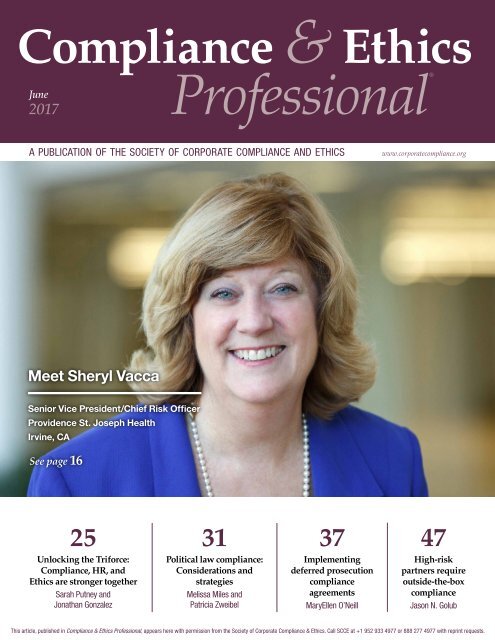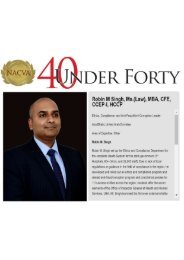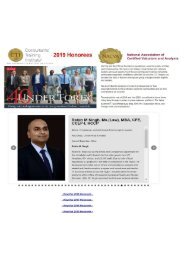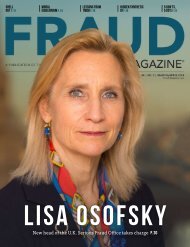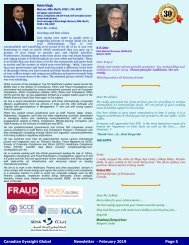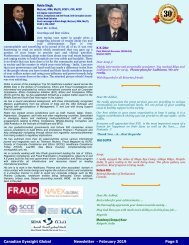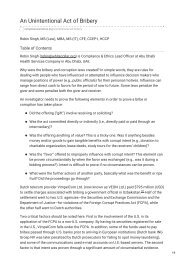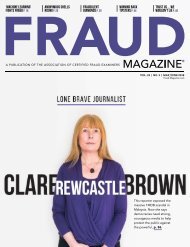Anti-bribery programs: A web of ethical and legal dilemmas
The role of the #iso37001 in curbing the #corruption and safeguarding organizations from #legal exposure with #robinsingh and #SCCE (Society of Corporate Compliance and Ethics)See Less by #RobinSingh the #whitecollarinvestigator
The role of the #iso37001 in curbing the #corruption and safeguarding organizations from #legal exposure with #robinsingh and #SCCE (Society of Corporate Compliance and Ethics)See Less by #RobinSingh the #whitecollarinvestigator
Create successful ePaper yourself
Turn your PDF publications into a flip-book with our unique Google optimized e-Paper software.
Compliance & Ethics<br />
June<br />
2017<br />
Pr<strong>of</strong>essional®<br />
A PUBLICATION OF THE SOCIETY OF CORPORATE COMPLIANCE AND ETHICS<br />
www.corporatecompliance.org<br />
Meet Sheryl Vacca<br />
Senior Vice President/Chief Risk Officer<br />
Providence St. Joseph Health<br />
Irvine, CA<br />
See page 16<br />
25<br />
Unlocking the Triforce:<br />
Compliance, HR, <strong>and</strong><br />
Ethics are stronger together<br />
Sarah Putney <strong>and</strong><br />
Jonathan Gonzalez<br />
31<br />
Political law compliance:<br />
Considerations <strong>and</strong><br />
strategies<br />
Melissa Miles <strong>and</strong><br />
Patricia Zweibel<br />
37<br />
Implementing<br />
deferred prosecution<br />
compliance<br />
agreements<br />
MaryEllen O’Neill<br />
47<br />
High-risk<br />
partners require<br />
outside-the-box<br />
compliance<br />
Jason N. Golub<br />
This article, published in Compliance & Ethics Pr<strong>of</strong>essional, appears here with permission from the Society <strong>of</strong> Corporate Compliance & Ethics. Call SCCE at +1 952 933 4977 or 888 277 4977 with reprint requests.
y Robin Singh, MS Law, MBA, MS IT, LPEC, CFE<br />
<strong>Anti</strong>-<strong>bribery</strong> <strong>programs</strong>:<br />
A <strong>web</strong> <strong>of</strong> <strong>ethical</strong> <strong>and</strong><br />
<strong>legal</strong> <strong>dilemmas</strong><br />
» All companies, whether public or private, are challenged to prevent <strong>bribery</strong> from becoming a part <strong>of</strong> their system.<br />
» Many developing countries are still struggling to set the right legislation for anti-<strong>bribery</strong> mechanisms, but<br />
international practices sometimes are not the best fit for their legislative <strong>and</strong> cultural systems.<br />
» In countries that have developed legislative structures, companies are looking to exp<strong>and</strong> their presence in<br />
economies that are plagued with regulatory pressures.<br />
» The new ISO 37001 anti-<strong>bribery</strong> st<strong>and</strong>ard provides organizations with a detailed framework to implement an<br />
effective anti-<strong>bribery</strong> program.<br />
» An entity looking to achieve a certification in ISO 37001 will not only build a stronger bond towards its<br />
stakeholders, but will also gain a competitive advantage in the market.<br />
Singh<br />
Bribery has become a key concern<br />
for organizations <strong>and</strong> state-level<br />
governments. Bribery features as the<br />
second highest median loss ($200,000 1 ) per<br />
scheme in an organization. It is interesting to<br />
note that the statistics provided by ACFE in<br />
their report show that organizations<br />
lost more than twice as much if<br />
they lacked anti-fraud controls. 2<br />
Bribery <strong>legal</strong>ly is comprised <strong>of</strong><br />
two categories:<br />
· Official <strong>bribery</strong> refers to<br />
corruption <strong>of</strong> a public <strong>of</strong>ficial.<br />
This is generally prosecuted as<br />
a criminal act.<br />
· Commercial <strong>bribery</strong> refers to the<br />
corruption <strong>of</strong> a private individual to gain<br />
a commercial or business advantage. This<br />
can be prosecuted as a criminal act <strong>and</strong> a<br />
civil action.<br />
The complication drives in when one<br />
has to evaluate if the “giver” or “receiver”<br />
has given/received something which is in<br />
“kind” <strong>and</strong> not cash. This gets even more<br />
complex when one has to evaluate a future<br />
promise provided by one <strong>of</strong> the parties to<br />
reap some benefits <strong>of</strong> their relationship.<br />
The complexity keeps on increasing with<br />
conflicts <strong>of</strong> interest <strong>and</strong> the like. The<br />
complexity keeps on growing <strong>and</strong> makes it<br />
all the more difficult to prove the following<br />
elements <strong>of</strong> crime, which generally the<br />
judicial systems tend to look for:<br />
· giving or receiving<br />
· a thing <strong>of</strong> value<br />
· with intent to corruptly influence<br />
· a business or a private decision<br />
This makes anti-fraud measures<br />
imperative, <strong>and</strong> that is why the International<br />
Compliance & Ethics Pr<strong>of</strong>essional ® June 2017<br />
+1 952 933 4977 or 888 277 4977 www.corporatecompliance.org 61
Compliance & Ethics Pr<strong>of</strong>essional ® June 2017<br />
Organization for St<strong>and</strong>ardization (ISO) has<br />
come up with the ISO 37001 st<strong>and</strong>ard. 3<br />
Comprised <strong>of</strong> the national st<strong>and</strong>ards<br />
bodies <strong>of</strong> its 163 member countries, the<br />
ISO develops <strong>and</strong> publishes international<br />
st<strong>and</strong>ards. To date, the ISO has developed<br />
some 20,000 voluntary international st<strong>and</strong>ards<br />
on a vast range <strong>of</strong> different topics. Its aim is to<br />
help organizations establish, implement, <strong>and</strong><br />
maintain an anti-<strong>bribery</strong> compliance program<br />
drawing on global anticorruption<br />
best practice.<br />
A new st<strong>and</strong>ard for<br />
compliance <strong>programs</strong><br />
The primary aim <strong>of</strong> ISO<br />
37001 <strong>and</strong> other anti<strong>bribery</strong><br />
frameworks is<br />
to help organizations<br />
establish an anti-<strong>bribery</strong><br />
management system<br />
to prevent <strong>bribery</strong> by<br />
the organization itself,<br />
by organizations within its supply chain,<br />
or by its staff or personnel. The <strong>bribery</strong> the<br />
st<strong>and</strong>ard seeks to prevent could be either for<br />
the organization’s benefit or in relation to<br />
its activities. The ISO st<strong>and</strong>ard itself is quite<br />
flexible <strong>and</strong> can adapt to a range <strong>of</strong> different<br />
organization types <strong>and</strong> sizes. This includes<br />
large organizations, small- <strong>and</strong> medium-sized<br />
enterprises (SMEs), public <strong>and</strong> privatesector<br />
organizations, <strong>and</strong> non-governmental<br />
organizations (NGOs).<br />
The ISO st<strong>and</strong>ard is designed to be used<br />
by any organization in any country, because<br />
it aims to strengthen an organization’s<br />
approach to compliance by improving policies,<br />
procedures, <strong>and</strong> controls. It emphasizes<br />
business operations, makes use <strong>of</strong> a risk-based<br />
approach, <strong>and</strong> outlines various m<strong>and</strong>ated<br />
procedures <strong>and</strong> controls. Subsequently, it<br />
helps organizations to better respond to <strong>and</strong><br />
underst<strong>and</strong> their operating context with<br />
Comprised <strong>of</strong> the<br />
national st<strong>and</strong>ards<br />
bodies <strong>of</strong> its 163 member<br />
countries, the ISO<br />
develops <strong>and</strong> publishes<br />
international st<strong>and</strong>ards.<br />
strong internal mechanisms, regardless<br />
<strong>of</strong> what the specifics <strong>of</strong> that context might<br />
be. This lends the st<strong>and</strong>ard both flexibility<br />
<strong>and</strong> versatility.<br />
The fact that the st<strong>and</strong>ard can theoretically<br />
be implemented in any context is a key<br />
advantage because, in today’s globalized<br />
economy, companies commonly have<br />
operations spread out across the globe in<br />
different jurisdictions. Adopting the st<strong>and</strong>ard<br />
at an organizational<br />
level facilitates uniform<br />
compliance, no matter<br />
the jurisdictions in<br />
which a company<br />
operates.<br />
To prevent <strong>bribery</strong>,<br />
the ISO st<strong>and</strong>ard<br />
m<strong>and</strong>ates a number<br />
<strong>of</strong> different controls,<br />
st<strong>and</strong>ards, <strong>and</strong><br />
procedures. These<br />
include:<br />
· A clear anti-<strong>bribery</strong> policy, along with<br />
procedures <strong>and</strong> controls in support <strong>of</strong><br />
that policy;<br />
· Top management <strong>and</strong> leadership<br />
commitment to <strong>and</strong> responsibility for<br />
enforcing the st<strong>and</strong>ard;<br />
· Senior-level oversight;<br />
· <strong>Anti</strong>-<strong>bribery</strong> training for management,<br />
staff, <strong>and</strong> personnel;<br />
· Risk assessments;<br />
· Due diligence on projects <strong>and</strong> business<br />
associates;<br />
· Reporting, monitoring, investigation, <strong>and</strong><br />
review; <strong>and</strong><br />
· Corrective action <strong>and</strong> continual<br />
improvement.<br />
However, although the ISO st<strong>and</strong>ard<br />
does <strong>of</strong>fer guidance to help organizations<br />
fully underst<strong>and</strong> the concept <strong>of</strong> <strong>bribery</strong>, it<br />
does not provide an independent definition<br />
62 www.corporatecompliance.org +1 952 933 4977 or 888 277 4977
<strong>of</strong> the term. This is because <strong>bribery</strong> is<br />
defined by a country’s own national laws<br />
<strong>and</strong>, therefore, the definition <strong>of</strong> <strong>bribery</strong><br />
inevitably varies between countries. For<br />
example, the Foreign Corrupt Practices<br />
Act does not see facilitation payments as<br />
bribes. However, the UK<br />
Bribery Act considers<br />
facilitation payments as<br />
il<strong>legal</strong>. In comparison, in<br />
the Middle East, the big<br />
booming oil economies<br />
charge a fee to expedite<br />
the process. This shows<br />
that countries may have<br />
various definitions <strong>of</strong><br />
what can or cannot be<br />
considered as a bribe.<br />
Using the ISO st<strong>and</strong>ard<br />
to measure a compliance program<br />
Although there are numerous practices that<br />
exist to measure a compliance program or<br />
an anti-<strong>bribery</strong> <strong>and</strong> corruption program, an<br />
ISO st<strong>and</strong>ard is treated as a gold st<strong>and</strong>ard<br />
for an organization. With any type <strong>of</strong><br />
compliance program, including ISO 37001,<br />
it is key to have established metrics that<br />
allow you to measure the effectiveness<br />
<strong>of</strong> a compliance program. Wellconstructed<br />
metrics facilitate performance<br />
improvement, effectiveness, efficiency, <strong>and</strong><br />
appropriate levels <strong>of</strong> internal control. The<br />
sources are a very important element <strong>of</strong><br />
these metrics, such as:<br />
· Regulatory sources, including laws,<br />
regulators, etc.<br />
· Non-regulatory sources, including<br />
policies, guidelines, etc.; <strong>and</strong><br />
· Other sources, which should ideally<br />
incorporate international leading<br />
practices relevant to the st<strong>and</strong>ard that<br />
is being measured as well as cost/risk/<br />
benefit analysis, when appropriate.<br />
Metrics are key to the<br />
overall success <strong>of</strong> a<br />
compliance program,<br />
so it is worth spending<br />
the time <strong>and</strong> energy<br />
to come up with the<br />
right metrics.<br />
During the implementation stage,<br />
there should be some objective metrics<br />
that provide insight into an organization’s<br />
progress toward meeting a specific goal or<br />
milestone in the implementation <strong>of</strong> an anticorruption<br />
policy.<br />
It is also very<br />
important to<br />
categorize these<br />
matrices <strong>and</strong> their<br />
applicability. One<br />
size cannot fit all,<br />
<strong>and</strong> thus, ideally,<br />
some metrics should<br />
be focused on the<br />
effectiveness <strong>of</strong> the<br />
program <strong>and</strong> some<br />
separate metrics<br />
should focus on the<br />
efficiency <strong>of</strong> your<br />
program. The bottom line is that every<br />
line item needs to be objectively quantified<br />
irrespective <strong>of</strong> the subjectivity <strong>of</strong> the matter<br />
(e.g., the number <strong>of</strong> calls to the corporate<br />
hotline, the percentage <strong>of</strong> employees who<br />
complete their trainings, or the number <strong>of</strong><br />
lawsuits filed against the organization).<br />
Thus, subjective measurements<br />
should be avoided, because they are<br />
inherently problematic. With metrics that<br />
can be objectively measured, it is easy to<br />
benchmark your program against specific<br />
st<strong>and</strong>ards. Numerical metrics can be<br />
particularly advantageous in this sense,<br />
allowing for trend <strong>and</strong> statistical analysis<br />
to see how the implementation <strong>of</strong> your<br />
compliance program is progressing <strong>and</strong><br />
how the program is performing once it is<br />
established <strong>and</strong> running. With subjective<br />
measurements, this becomes unfeasible.<br />
Metrics are key to the overall success<br />
<strong>of</strong> a compliance program, so it is worth<br />
spending the time <strong>and</strong> energy to come up<br />
with the right metrics. Some <strong>of</strong> the key<br />
Compliance & Ethics Pr<strong>of</strong>essional ® June 2017<br />
+1 952 933 4977 or 888 277 4977 www.corporatecompliance.org 63
Compliance & Ethics Pr<strong>of</strong>essional ® June 2017<br />
questions in a matrix could surround the<br />
following subjects:<br />
· Is the program consistent with all laws<br />
relevant to countering <strong>bribery</strong> in each <strong>of</strong><br />
the jurisdictions in which you operate?<br />
· Is the program evolving? (i.e., do the<br />
investigation/compliance reviews tie<br />
back to the regulatory risk register <strong>and</strong><br />
subsequently to the program?)<br />
· How is the program managed, <strong>and</strong> how<br />
does it tie up with the jurisdictional<br />
exceptions where the business<br />
entities operate?<br />
Not only will the questions provide<br />
a useful overview <strong>of</strong> compliance status,<br />
but they can also help an organization to<br />
correlate risk assessments, prioritize risk, <strong>and</strong><br />
provide valuable management information<br />
for both process improvement <strong>and</strong> quality<br />
improvement.<br />
Defining the maturity <strong>of</strong> an anti-<strong>bribery</strong><br />
compliance program<br />
This is a very touchy subject because<br />
the set-up period in the life cycle <strong>of</strong> a<br />
compliance program requires patience <strong>and</strong><br />
perseverance. Management will not see a<br />
measurable output for the amount <strong>of</strong> input<br />
that requires so many resources, employees,<br />
<strong>and</strong> budget. Compliance <strong>programs</strong> do not<br />
mature overnight, but rather take time to<br />
develop <strong>and</strong> become entrenched. A program<br />
in its implementation phase will likely<br />
be relatively inflexible <strong>and</strong> will only see<br />
minimum levels <strong>of</strong> compliance, as it likely<br />
doesn’t have anticipator capacity at this point.<br />
As the program matures, it will become<br />
more flexible, proving itself able to learn<br />
from, provide management with a tangible<br />
output, <strong>and</strong> adapt to different regulatory<br />
scenarios. Staff <strong>and</strong> personnel in the program<br />
will also become more knowledgeable, <strong>and</strong><br />
the program will generally become more<br />
integrated with other units. As the program<br />
matures, gains in efficacy <strong>and</strong> efficiency can<br />
be expected.<br />
The maturity should never be looked at<br />
in isolation, but rather in the context <strong>of</strong> the<br />
business <strong>and</strong> its growth. After all, a Compliance<br />
department is a cost center <strong>and</strong> needs to justify<br />
its existence. Some <strong>of</strong> the elements in a mature<br />
compliance program could incorporate:<br />
· Technical <strong>and</strong> business tools are used to<br />
enhance an organization’s competitive<br />
advantage;<br />
· Budgeted resources are maximized, because<br />
tasks are better planned <strong>and</strong> coordinated;<br />
· The program has maximum flexibility <strong>and</strong><br />
is “anticipatory” in the sense that it can<br />
anticipate <strong>and</strong> respond to needs;<br />
· Staff <strong>and</strong> personnel can assist government<br />
regulators in setting st<strong>and</strong>ards <strong>and</strong> policies;<br />
<strong>and</strong><br />
· Business relationship with third parties<br />
are enhanced.<br />
Implementing the value <strong>of</strong> compliance<br />
A compliance program or an anti-<strong>bribery</strong><br />
program can be a valuable resource for<br />
companies seeking to develop <strong>and</strong> implement<br />
an anti-<strong>bribery</strong> st<strong>and</strong>ard <strong>and</strong> curb any criminal/<br />
un<strong>ethical</strong> conduct that might exist. Frameworks,<br />
including the ISO 37001, can help organizations<br />
that operate outside the jurisdictions <strong>of</strong> the<br />
U.S., UK, or Europe to respond to allegations<br />
<strong>of</strong> <strong>bribery</strong> <strong>and</strong> corruption. By implementing<br />
a compliance program that adheres to ISO<br />
37001 in the jurisdiction, a company can<br />
empower local staff to stop perpetuating acts<br />
that can lead to dem<strong>and</strong>s for bribes <strong>and</strong> protect<br />
their organizations in the ever-changing<br />
regulatory environment.<br />
ISO 37001 is being developed as a<br />
requirements st<strong>and</strong>ard, meaning that it will,<br />
at some point, be capable <strong>of</strong> independent<br />
verification. It will therefore be possible for a<br />
third party to verify whether or not a company<br />
64 www.corporatecompliance.org +1 952 933 4977 or 888 277 4977
is adhering to the st<strong>and</strong>ard, <strong>and</strong> an organization<br />
may even be able to become certified in<br />
compliance. This enhances the enforceability <strong>of</strong><br />
the st<strong>and</strong>ard in a global context <strong>and</strong> increases its<br />
overall value to private enterprise.<br />
For example, a US company operating in<br />
Zimbabwe—a jurisdiction characterized by<br />
very high levels <strong>of</strong> corruption at all levels <strong>of</strong><br />
government—could chose to implement a<br />
compliance program in accordance with the<br />
ISO st<strong>and</strong>ard to prevent local employees from<br />
paying bribes to <strong>of</strong>ficials. Local staff would be<br />
empowered to reject requests for bribes on the<br />
grounds that they could lose their jobs if they<br />
were to pay out the bribe money <strong>and</strong> that the<br />
company could lose its certification.<br />
In this context, the implementation <strong>of</strong><br />
a compliance program would also help to<br />
mitigate the risks <strong>of</strong> <strong>bribery</strong> <strong>and</strong> corruption<br />
in the supply chain. As part <strong>of</strong> a compliance<br />
program, the aforementioned US company<br />
operating in Zimbabwe could require that all<br />
<strong>of</strong> its suppliers become ISO 37001 certified. This<br />
would <strong>of</strong>fer the organization protection from<br />
the risks <strong>of</strong> <strong>bribery</strong> <strong>and</strong> corruption at all levels.<br />
Conclusion<br />
By adhering to this st<strong>and</strong>ard <strong>and</strong><br />
demonstrating that they have done so,<br />
companies can in turn increase their own<br />
value. ISO 37001 adherence provides assurance<br />
to management, investors, employees,<br />
customers, <strong>and</strong> other stakeholders that an<br />
organization is taking steps to prevent <strong>bribery</strong><br />
risk <strong>and</strong> clear evidence that an organization<br />
has taken reasonable steps to stop <strong>bribery</strong>. ✵<br />
1. Association <strong>of</strong> Certified Fraud Examiners (ACFE): Report to the<br />
Nations on Occupational Fraud <strong>and</strong> Abuse: 2016 Global Fraud Study,<br />
Executive Summary. Available at http://bit.ly/acfe-2016-GFS<br />
2. ACFE: The Staggering Cost <strong>of</strong> Fraud infographic. Available at<br />
http://bit.ly/cost-<strong>of</strong>-fraud<br />
3. ISO 37001 <strong>Anti</strong>-<strong>bribery</strong> management systems. Available at<br />
http://bit.ly/anti-bribe<br />
Robin Singh (robinsingh002@yahoo.com) is Compliance & Fraud<br />
Control Lead at Abu Dhabi Health Services Company in Abu Dhabi, UAE.<br />
whitecollarinvestigator.com @drobinsingh bit.ly/li-RobinSingh<br />
Advertise with us!<br />
Compliance & Ethics Pr<strong>of</strong>essional ®<br />
is a trusted resource for<br />
compliance <strong>and</strong> ethics pr<strong>of</strong>essionals. Advertise with us <strong>and</strong><br />
reach decision-makers!<br />
For subscription information <strong>and</strong> advertising rates, contact<br />
Liz Hergert at +1 952 933 4977 or 888 277 4977 or<br />
liz.hergert @ corporatecompliance.org.<br />
SCCE’s magazine is published monthly <strong>and</strong> has a current<br />
distribution <strong>of</strong> more than 6,000 readers. Subscribers include<br />
executives <strong>and</strong> others responsible for compliance: chief compliance<br />
<strong>of</strong>ficers, risk/ethics <strong>of</strong>ficers, corporate CEOs <strong>and</strong> board members,<br />
chief financial <strong>of</strong>ficers, auditors, controllers, <strong>legal</strong> executives,<br />
general counsel, corporate secretaries, government agencies,<br />
<strong>and</strong> entrepreneurs in various industries.<br />
Compliance & Ethics<br />
May<br />
2017<br />
®<br />
Pr<strong>of</strong>essional<br />
A PUBLICATION OF THE SOCIETY OF CORPORATE COMPLIANCE AND ETHICS<br />
Meet Maurice Gilbert<br />
Managing Director<br />
Conselium Compliance Executive Search<br />
Dallas, Texas<br />
See page 16<br />
25<br />
Recording the<br />
interview: Best<br />
practices for compliance<br />
pr<strong>of</strong>essionals, Part 1<br />
Daniel Coney<br />
35<br />
What can we<br />
do to improve<br />
engagement on<br />
our own teams?<br />
Jessica Tjornehoj<br />
39<br />
A look into<br />
Europe’s new<br />
cybersecurity regimes<br />
Jan Dhont <strong>and</strong><br />
Delphine Charlot<br />
www.corporatecompliance.org<br />
45<br />
The prosecutor’s<br />
evolving playbook:<br />
DOJ’s rising expectations<br />
for compliance <strong>programs</strong><br />
Peter Anderson<br />
Compliance & Ethics Pr<strong>of</strong>essional ® June 2017<br />
+1 952 933 4977 or 888 277 4977 www.corporatecompliance.org 65


